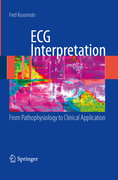
Over the last decade, there has been a tremendous improvement in our understanding of basic cardiac electrophysiology. Most introductory ECG books teach via pattern recognition and do not incorporate new pathophysiologic information.There is a great need for a simple book that teaches electrocardiography froma pathophysiologic basis. The proposed paperback book will be small format, concise, and 200-pages in length. It can be utilized as a reference - chapter by chapter or read throughout for an overview. Each chapter will feature ten questions that will provide a chapter review. Ten case studies will be highlighted at the end of the book that will integrate the multiple principles of electrocardiography. INDICE: Introduction to cardiac anatomy and electrophysiology.- Introduction to the physics of electrocardiography and the correlation between eletrophysiology and electrocardiography.- The Normal ECG.- Chamber enlargement.- Conduction disturbances (His Purkinje tissue).- Coronary artery disease.- Miscellaneous patterns.- Bradyarrhythmias.- Premature beats.- Classification of Tachycardias.- Wide complex tachyarrhythmias.- Pacemakers.- How to analyze an ECG.- Differential diagnosis of specific electrocardiographic patterns.- Case studies.- Index.
- ISBN: 978-0-387-88879-8
- Editorial: Springer
- Encuadernacion: Rústica
- Páginas: 302
- Fecha Publicación: 02/04/2009
- Nº Volúmenes: 1
- Idioma: Inglés
